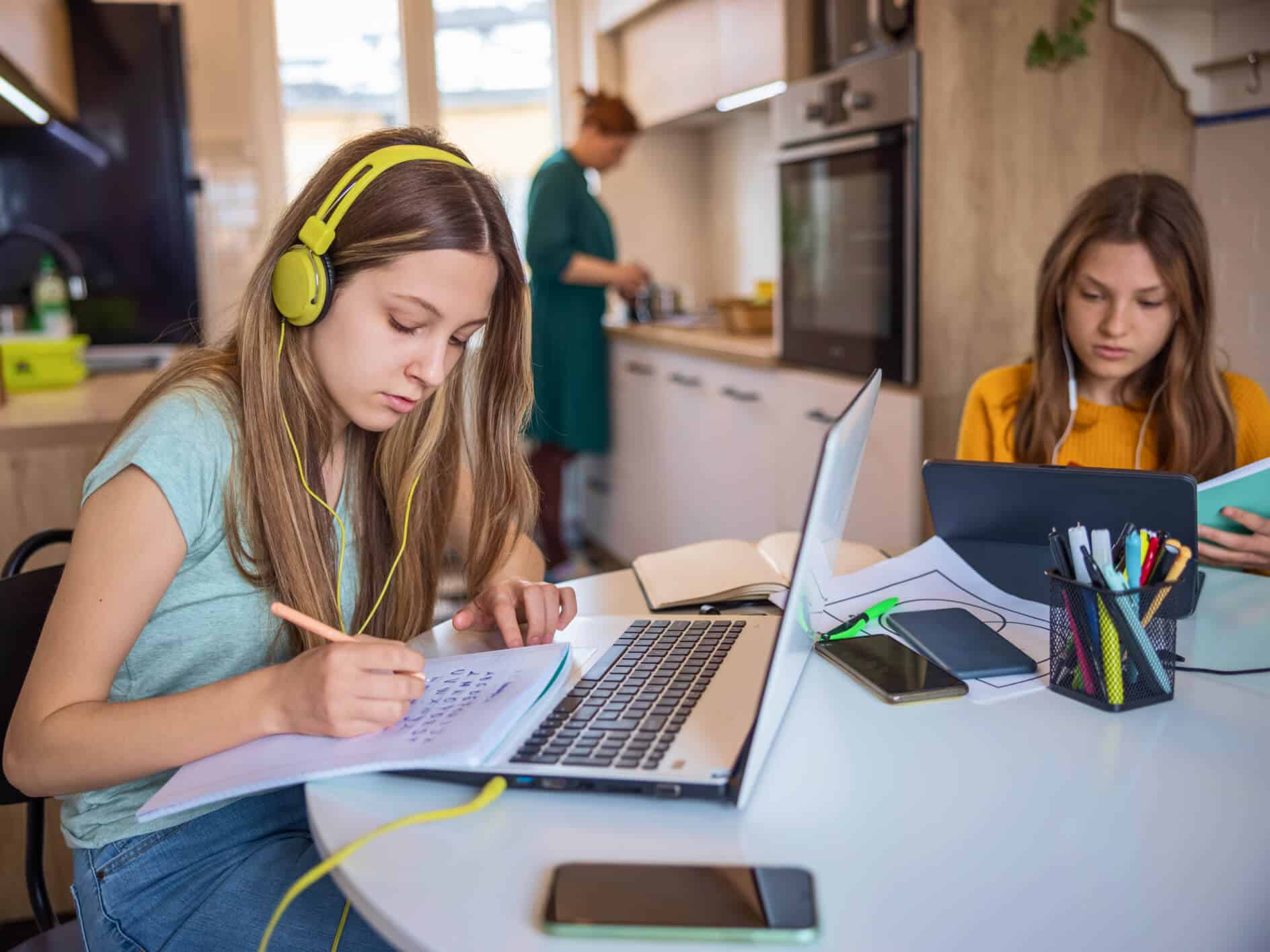While online courses offer flexibility and convenience, they also present unique challenges. Mastering an effective online learning routine is crucial for ensuring that students can thrive in this environment. Common challenges include distractions, difficulty staying organized, and technical issues. Establishing a consistent routine can address these issues by creating a structured learning environment.
If your student’s daily routine needs a refresh, keep reading. This blog is packed with valuable insights and practical tips to help students succeed in online learning. From setting up a daily routine to staying motivated, we’ve got you covered!
The basics of mastering an online learning routine
For online students, having a solid remote learning routine can make all the difference. It might seem challenging at first, but with a few simple steps, they’ll be on your way to mastering the art of online learning.
Start with these basics to help your student stay organized, focused, and on track to reach their academic goals this school year:
- Consistency is crucial: For students with unique commitments, like athletes or actors, flexibility is essential, but for others, creating a daily schedule and sticking to it is key. When possible, develop a daily schedule that includes start times, breaks, and designated periods for different subjects.
- Avoid distractions during study time: Limit distractions by setting rules for study time. This may include turning off notifications, limiting access to social media, and creating a distraction-free zone.
- Understand common troubleshooting issues: Familiarize yourself and your student with the technology used for online classes. Have a troubleshooting plan in place to quickly address common issues like connectivity problems or software glitches.
- Join virtual study groups or clubs to connect with peers: Encourage your student to join virtual study groups or extracurricular clubs. This helps them stay connected with peers and promotes a sense of community.
Schedules and routines for different types of students
Whether your student is in elementary, middle, or high school, it’s important to establish a consistent schedule and routine to enhance their learning experience. This can help them stay organized and on track with their online classes.
No matter your student’s age, all online learning routines should consider:
- Flexibility: Adapt the schedule to fit the student’s needs and energy levels.
- Consistency: Maintain consistent routines to create a sense of normalcy and predictability.
- Engagement: Incorporate the student’s interests into learning activities to keep them engaged.
- Breaks: Regular breaks are essential for maintaining focus and reducing screen fatigue.
Elementary School Students
Creating a structured and engaging online learning routine for an elementary student is crucial to their success. When creating an online routine for your young learner, be sure to consider these factors:
- Short Attention Spans: Plan shorter, more varied activities to keep younger students engaged.
- Parental/Guardian Assistance: Parents/guardians will often need to help with technology and navigating online platforms.
- Physical Activity: Include frequent movement breaks and physical activities to channel their energy.
- Creative Activities: Incorporate arts, crafts, music, and other creative endeavors to stimulate imagination.
- Simple Instructions: Provide clear, simple instructions and visual aids to guide learning.
Here’s an example of a daily schedule that balances academic activities, physical movement, and breaks:
- 8 – 8:30 a.m.: Morning Routine
- Wake up, have breakfast, get dressed, and prepare the learning space with necessary supplies.
- 8:30 – 9 a.m.: Morning Check-In
- Review the day’s schedule, set goals, and briefly interact with classmates and teachers.
- 9 – 10 a.m.: School Work
- Focus on a core subject with interactive lessons and activities using online tools and resources.
- 10 – 10:15 a.m.: Movement Break
- Engage in physical activity such as stretching, yoga, or a short outdoor walk.
- 10:15 – 11:15 a.m.: School Work
- Focus on a core subject with interactive lessons and activities using online tools and resources.
- 11:15 a.m. – 12 p.m.: Creative Time
- Work on art projects, music, or any creative subject to explore interests and talents.
- 12 – 1 p.m.: Lunch Break
- Have a healthy meal and some free time, with an optional short video call with friends or family to socialize.
- 1 – 2 p.m.: School Work
- Focus on a core subject with interactive lessons and activities using online tools and resources.
- 2 – 2:15 p.m.: Movement Break
- Another session of physical activity to re-energize.
- 2:15 – 3 p.m.: School Work
- Focus on a core subject with interactive lessons and activities using online tools and resources.
- 3 – 3:30 p.m.: Independent Quiet Time
- Read a book of choice or engage in silent reflection to wind down.
- 3:30 – 4 p.m.: End-of-Day Review
- Discuss what was learned, review achievements, and plan for the next day.
- 4 p.m. Onward: Free Time
- Allocate time for hobbies, sports, or unstructured play.
Middle School Students
Middle schoolers can benefit from a bit more independence in their online learning routine as well as plenty of socialization time. When helping your middle school student set their online learning routine, consider these factors:
- Developing Independence: Encourage self-directed learning and responsibility but still provide guidance.
- Social Interaction: Facilitate opportunities for social interaction with peers through group projects and discussions.
- Variety of Subjects: Include a broader range of subjects to cater to diverse interests and aptitudes.
- Critical Thinking: Incorporate activities that promote critical thinking and problem-solving skills.
- Exploring Interests: Allow time for students to explore personal interests through elective subjects or extracurricular activities.
Here’s an example of a daily schedule that balances academic activities, socialization, independent study, and breaks:
- 8 – 8:30 a.m.: Morning Routine
- Wake up, have breakfast, get dressed, and prepare the learning space with necessary supplies.
- 8:30 – 9 a.m.: Morning Check-In
- Review the day’s schedule, set goals, and briefly interact with classmates and teachers.
- 9 – 10 a.m.: Core Subject 1
- Focus on a core subject with interactive lessons and activities, promoting critical thinking.
- 10 – 10:15 a.m.: Movement Break
- Engage in physical activity such as stretching, yoga, or a short outdoor walk.
- 10:15 – 11:15 a.m.: Core Subject 2
- Focus on a core subject with interactive lessons and activities, promoting critical thinking.
- 11:15 a.m. – 12 p.m.: Social Interaction/Group Project
- Work on group projects or engage in discussions with peers to develop communication skills.
- 12 – 1 p.m.: Lunch Break
- Have a healthy meal and some free time, with optional video calls with friends or family.
- 1 – 2 p.m.: Core Subject 3
- Focus on a core subject with interactive lessons and activities, promoting critical thinking.
- 2 – 2:15 p.m.: Movement Break
- Another session of physical activity to re-energize.
- 2:15 – 3 p.m.: Core Subject 4
- Focus on a core subject with interactive lessons and activities, promoting critical thinking.
- 3 – 3:45 p.m.: Elective/Creative Time
- Engage in art, music, coding, or any elective subject to explore personal interests.
- 3:45 – 4 p.m.: End-of-Day Review
- Discuss what was learned, review achievements, and plan for the next day.
- 4 p.m. Onward: Free Time/Extracurricular Activities
- Allocate time for hobbies, sports, or unstructured play to explore interests further.
High School Students
High school students have different needs and challenges when it comes to online learning. Here are some things to consider for helping your high school student set up virtual learning routine:
- Academic Rigor: Plan for longer, more in-depth study sessions to cover complex topics.
- College and Career Preparation: Include activities that prepare students for post-secondary education and careers, such as SAT prep, college counseling, or vocational training.
- Time Management: Teach and encourage effective time-management skills to balance academic and personal responsibilities.
- Independent Learning: Promote autonomy by encouraging independent study and research projects.
- Advanced Technology Use: Utilize more sophisticated online tools and resources that high school students can navigate independently.
Here’s an example of a daily schedule that balances academic activities, college and career preparation, independent study, and breaks:
- 7:30 – 8 a.m.: Morning Routine
- Wake up, have breakfast, get dressed, and prepare the learning space with necessary supplies.
- 8:00 – 8:30 a.m.: Morning Planning/Check-In
- Review the day’s schedule, set goals, and plan tasks to develop time-management skills.
- 8:30 – 10 a.m.: Core Subject 1
- In-depth study session focusing on topics using interactive online tools and resources.
- 10 – 10:15 a.m.: Movement Break
- Engage in physical activity such as stretching, yoga, or a short outdoor walk.
- 10:15 – 11:45 a.m.: Core Subject 2 (English Language Arts)
- Participate in comprehensive reading and writing assignments, promoting critical analysis.
- 11:45 a.m. – 12:30 p.m.: College and Career Prep
- Activities like SAT prep, college counseling, vocational training, or career exploration.
- 12:30 – 1:30 p.m.: Lunch Break
- Have a healthy meal and some free time, with optional video calls with friends or family.
- 1:30 – 3 p.m.: Core Subject 3
- In-depth study session focusing on topics using interactive online tools and resources.
- 3 – 3:15 p.m.: Movement Break
- Another session of physical activity to re-energize.
- 3:15 – 4:15 p.m.: Independent Study/Research Projects
- Self-directed study or research projects that promote autonomy and deep learning.
- 4:15 – 5:00 p.m.: Elective/Creative Time
- Engage in elective subjects such as art, music, coding, or other areas of personal interest using advanced technology.
- 5:00 – 5:30 p.m.: End-of-Day Review
- Discuss what was learned, review achievements, plan for the next day, and manage tasks.
- 5:30 p.m. Onward: Free Time/Extracurricular Activities
- Allocate time for hobbies, sports, or unstructured play to relax and explore interests further.
How you can support your student’s success in online learning
Whether you’re a parent, guardian, or mentor, your role is crucial in helping your student succeed. There are plenty of ways you can make a positive impact. Let’s explore some simple yet effective strategies to support your student on their online learning journey.
Communicating with teachers and staying updated on assignments
Open communication with teachers is crucial. Regularly check in on your child’s progress and stay updated on assignments and expectations.
Providing support and guidance without being too involved
Offer help when needed but encourage independence. Allow your child to take responsibility for their learning while being there to guide them.
Encouraging breaks and physical activity
Ensure your child takes regular breaks and incorporates physical activity into their day. This helps maintain focus and reduce stress.
Collaborating with other parents to create a support system
Connect with other parents to share tips, resources, and support. A strong community can make a significant difference.
How to help students stay motivated during online learning
Keeping students motivated during online learning can sometimes feel like a challenge, but it’s definitely doable with the right approach. Your encouragement and support play a huge role. From developing engaging activities to providing positive reinforcement, there are many ways to keep that spark alive.
Ready to boost your student’s motivation? Let’s review some practical tips and tricks that can make online learning exciting and rewarding:
- Setting goals and rewards: Set achievable goals and reward your child for meeting them. This can be a powerful motivator.
- Finding ways to make learning fun and engaging: Incorporate fun activities and interactive lessons to keep your child engaged and excited about learning.
- Practicing self-care and managing stress: Teach your student the importance of self-care, including mindful practices and stress management techniques.
- Remembering the benefits of online learning: Remind your child of the unique benefits of online learning, such as flexibility and the ability to learn at their own pace.
Common roadblocks in online learning and how to overcome them
Online learning offers incredible flexibility and convenience, but it’s not without its challenges. From staying focused amid distractions to managing time effectively, students can encounter several roadblocks along the way.
The good news? These obstacles can be overcome with the right strategies and mindset. Let’s dive into some common hurdles students might face and discover practical solutions to keep them on the path to success:
- Procrastination: Address procrastination by setting clear expectations and using tools like timers to manage study sessions.
- Frustration with technology or assignments: Encourage patience and have a plan for troubleshooting tech issues. For difficult assignments, break tasks into manageable chunks.
- Balancing school work with other responsibilities: Help your student prioritize tasks and create a balanced schedule that accommodates both school work and other responsibilities.
- Struggling to stay organized: Use planners, digital tools, or checklists to help your child stay organized and on top of their assignments.
Final thoughts and tips for success
With the right strategies and support, your student can thrive in online learning. Stay engaged, be patient, and celebrate their achievements. By following the above tips and staying proactive, parents/guardians can help their students excel in online learning.
Considering online school for your student?
Preparing for online school is easier than many parents/guardians think. ASU Prep Digital is a great option to consider if you want to explore the flexibility and personalization of an online school program.
At ASU Prep Digital we have a team dedicated to helping you navigate the enrollment process. We believe that every child and their family should be able to have an education that is unique and easily accessible.
ASU Prep Digital is an accredited online school program serving students in grades K–12, recognized as Arizona’s #1 Online School by Niche.com. Our unique teaching model supports students from the safety of their homes with the latest learning technologies and several layers of personalized instruction and coaching. In addition, our program is a college prep option where online high school and university courses converge, preparing students for college acceptance and encouraging them to start earning credit toward college majors and careers.
We support districts in Arizona, while serving students and schools around the world. To learn more about ASU Prep Digital, please visit our website.
Mastering the online learning routine for K–12 students FAQs
How long is each day in online school?
The length of each day in online school can vary depending on the student’s grade level and individual schedule. Elementary students typically have shorter days, ranging from 2-3 hours, while middle and high school students may have longer days, around 4-6 hours. However, it is important to note that unlike a traditional classroom setting, online learning allows for flexibility in scheduling and breaks throughout the day.
How can I establish a productive online learning routine?
Establishing a productive online learning routine is crucial for success. Here are some tips to help you get started:
- Set a schedule: Just like in a traditional school setting, it’s important to have a set schedule for your online learning. This will help you stay on track and ensure that you are completing all of your assignments and attending virtual classes.
- Create a designated workspace: Find a quiet and comfortable place to work where you have access to all of your materials. Having a dedicated workspace will help minimize distractions and keep you focused.
- Take breaks: It can be tempting to power through the day without taking any breaks, but this can lead to burnout and decreased productivity. Make sure to schedule breaks throughout the day to give your mind and body a rest.
- Stay organized: With online learning, it’s easy to lose track of assignments and due dates. Make sure to keep a planner or use digital tools to stay organized and on top of your work.
- Communicate with teachers: Don’t be afraid to reach out to your teachers if you have any questions or need clarification on assignment instructions. They are there to help you succeed in your online learning journey.
What are some effective online learning strategies for maintaining a consistent study routine?
Maintaining a consistent study routine in an online learning environment can be challenging, but with the right strategies, students can stay on track and make the most of their educational experience. Here are some effective strategies:
- Establish a clear schedule
- Set specific goals
- Use technology wisely
- Actively engage with learning materials
- Practice self-discipline
- Incorporate healthy habits
- Reflect and adjust as necessary
- Stay positive and reward yourself!






